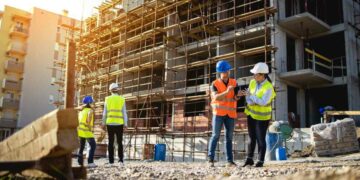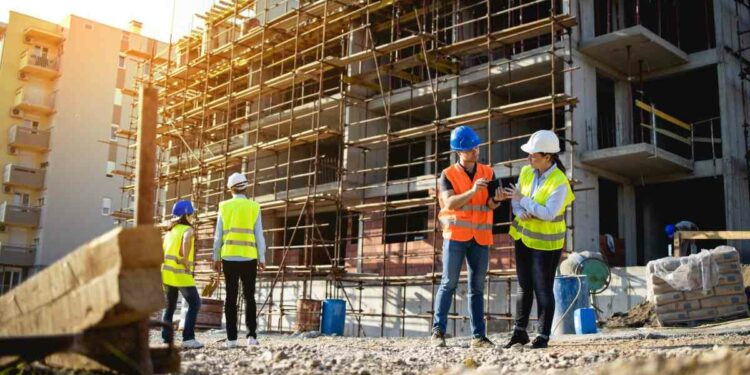Fabric buildings are ushering in a new era in the construction industry. Often made of steel frames and weather-resistant membranes, these structures are now attracting attention traditionally reserved for conventional buildings.
But how do these two types of buildings stack up for your construction requirements?
This article aims to guide you through this comparison. By exploring the advantages and disadvantages of each, you’ll feel better placed to make an informed decision best suited to your project.
Table of Contents
Fabric Buildings
Fabric buildings, once overlooked, are now gaining recognition in the construction industry, largely due to technological progress. This advancement has ushered in the era of engineered fabric structures.
Unlike traditional fabric buildings, these modern structures are designed with a keen focus on safety and functionality. They take into account elements such as wind load, snow load, and other environmental factors.
If you’re considering adopting this innovative approach, experts specializing in engineered fabric buildings can assist in setting up structures such as:
- Tension fabric buildings – These structures use a rigid frame, typically steel or aluminum, over which a tensioned fabric is stretched. They’re commonly used in sports facilities, warehouses, and aircraft hangars due to their ability to span large areas without internal support columns.
- Air-supported (inflatable) buildings – These buildings maintain their shape and structural stability through air pressure within a fabric envelope. They’re often used for temporary or seasonal facilities, such as sports domes or event tents.
- Tensile structures – These buildings are characterized by the tensioning of the fabric or flexible membrane, often supported by cabling or rigid elements. They’re frequently used in stadiums, pavilions, or concert halls due to their innovative and aesthetically pleasing designs.
These are just a few examples of the possibilities offered by engineered fabric buildings, each with its unique benefits.
Pros Of Fabric Buildings
Here are some of the pros of fabric buildings:
- Fabric buildings typically come with a lower price tag than conventional structures. They require less labor and materials, translating into significant cost savings.
- The maintenance cost over the building’s lifespan can be considerably lower, owing to the inherent durability and corrosion resistance of the materials used.
- The materials are light, easy to handle, and the design is often modular, which enables rapid assembly and disassembly.
- Engineered fabric buildings can be easily expanded, reduced, or even relocated to a new site. This makes them a fantastic choice for industries that require flexibility.
- The translucent nature of the fabric used allows for optimal daylight penetration. This reduces the need for artificial lighting, contributing to energy efficiency.
These are some of the advantages. However, they also come with a few setbacks.
Cons Of Fabric Buildings
While these structures have many advantages, they also have disadvantages. Here are a few:
- Although fabric buildings are designed to withstand harsh weather conditions, their lifespan may not rival that of well-maintained conventional structures.
- Architecturally, fabric buildings don’t provide the same wide range of design possibilities as conventional structures.
- Insulating a fabric building can be more challenging than a conventional building, potentially making it less suitable for environments that require significant temperature regulation.
Despite these drawbacks, let’s shift our focus to conventional structures for a balanced comparison.

Conventional Structures
Traditional homes are usually built following a conventional procedure, employing materials such as concrete, brick, wood, and steel.
Pros Of Conventional Structures
Here are some of the advantages of these structures:
- If well-maintained, conventional structures can stand the test of time. It’s not unusual to encounter brick and steel buildings that have weathered the elements for several decades or even centuries.
- The flexibility in design that conventional materials offer can’t be overstated. They lend themselves to a wide range of architectural styles and aesthetics, allowing for truly unique and bespoke designs.
- Conventional buildings often provide superior insulation, making them a strong choice in climates that require stringent environmental control.
These are the potential benefits of choosing conventional structures for your project. However, this approach does come with its limitations.
Cons Of Conventional Structures
Here are some of the disadvantages:
- Conventional structures can be cost-prohibitive due to the high price of materials and labor-intensive construction processes.
- Building a conventional structure is usually a slow process, with projects lasting several months to years.
- Expanding or modifying a conventional structure can be complex, disruptive, and expensive.
These are some of the drawbacks when comparing conventional structures to fabric buildings. Nevertheless, evolving construction trends, such as the use of modular or prefabricated components, are significantly enhancing the efficiency of traditional structures.
Choose Today
In choosing between fabric buildings and conventional structures, consider your specific needs, resources, and the building’s intended function. While fabric buildings excel in cost-effectiveness, flexibility, and speed of construction, conventional buildings offer superior durability, design versatility, and insulation.
The rapid evolution of engineered fabric building technology, however, is closing this gap. With advancements in fabric strength, insulation, and architectural possibilities, these structures are becoming increasingly competitive.
Your decision should hinge on a thorough evaluation of your project’s unique requirements and long-term objectives. By doing so, you will ensure a choice that meets your immediate needs but also stands as a worthy investment for the future.



















